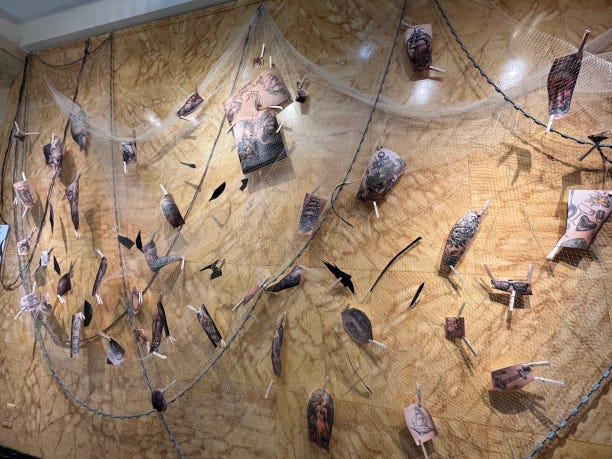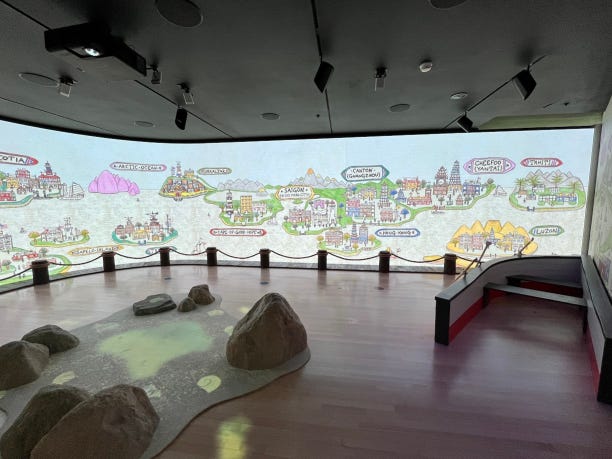Two Great Museums in Savannah, GA!
Ships of the Sea Maritime Museum / Telfair Museums' Jepson Center & Children's Art Museum
Hi everyone! I’m excited to recap some museums highlights from my recent trip to Savannah, Georgia. Whenever I travel, I definitely have to make time to check out some museums, and I was not disappointed! Today I’ll talk about the two museums I visited.
First up is the Ships of the Sea Maritime Museum, located a short walk from River Street and Bay Street, the two main tourist streets. The museum (see above) is part of the William Scarborough House and Gardens, built in 1819 for the original owner of the property, who was the president of the Savannah Steamship Company, which launched the SS Savannah, the first steamship to cross the Atlantic Ocean!
I really liked the art installation they had in the garden, entitled Seven Sisters by Abigail Tankersley. The information panel says that it’s made of maritime rope tied into Josephine knots that were donated by longtime Savannah shrimper James “Frank” Dubberly before his passing in 2024. The titular Seven Sisters refers to the Pleiades constellation, which has been used for navigation since ancient times. The sign further says that “the work reflects Savannah’s deeply rooted maritime heritage while also resonating with broader themes of unity and longevity…” and I definitely got that as I explored Savannah and learned more about the city’s history!
Ok, on to the main draw of the museum — the plethora of intricately-detailed model ships! There are ships of all sizes from Savannah’s history. This is one of the first you see in the museum, called the Languedoc. This was one of the 22 French warships that sailed from the West Indies in 1779 to aid the 13 Colonies in the Revolutionary War. The French and American forces surrounded British Savannah, but were unable to take the city and retreated in failure. I definitely believe that a great hook goes a long way, and I was completely wowed from the get-go!
I also ended up at the museum during their special exhibition run, Sea of Ink. Tattoos are a time-honored maritime tradition, and not only does this exhibit showcase that history, but it also documents the stories behind Savannahians’ tattoos through photography and interviews, including with the artists of the tattoos. As someone with one small tattoo, I know how much meaning can go into them, so I found it very moving to hear the stories of people who spent their whole lives working in the maritime industries or who have served overseas and commemmorated their service with tattoos.
Tattoos, have held much military significance, going back all the way to the 1800s at least according to the exhibit. I loved this diagram of certain popular U.S. WWII tattoos. I’d seen some of them, but never knew what they meant until now!
Speaking of WWII, one of the largest model ships in the museum’s collection is the U.S.S. Savannah. Not the first, nor the last ship to bear the name Savannah, this one was built in New Jersey and completed in 1937 and saw lots of action in WWII in the North African and Italian campaigns. During the latter, she sustained damage from a German bomb at the Allied landing in Salerno. After being repaired in Philadelphia, Savannah was part of a convoy of vessels that escorted President Roosevelt to the Yalta Conference in January 1945. This particular model was built for the U.S. Navy Department according to the museum, so I think it’s really cool that it’s on display here as a testament to the legacy of the Savannah Line. Originally, this referred to the Ocean Steamship Company’s fleet that carried passengers and cargo between Savannah, Boston, and New York from 1872-1942. As technological advances became available, the company built iron-hulled ships. Eventually, their ships were chartered by the U.S. Navy in both World Wars. However, by 1948, all of their ships were either sunk or sold for scrap.
Overall, there was SO MUCH packed into the Ships of the Sea Maritime Museum, and I loved seeing all of the tiny details on each of the models and imagining what the ships would have been like in their true scale. I’d definitely recommend visiting if you are interested in history or just like to appreciate the great craftsmanship!
The second museum I visited was the Telfair Museums’ Jepson Center & Telfair Children’s Art Museum. The Telfair Museums were founded in 1883 through the bequest of prominent local philanthropist Mary Telfair, who left her house to the Georgia Historical Society, which became the Telfair Academy of Arts and Sciences. Located a stone’s throw away is the Jepson Center, a modern addition built in 2006. I chose to visit this part of the museum complex specifically, since I’d already visited one historic house in Savannah.
I really loved one of the smaller current exhibits, A Tour of Savannah. It features a hallway of paintings by 26 Georgia artists who competed in the 6th Annual Georgia Color Plein Air event in 2024, as well as six artists from the museum’s Plein Air Painting Art Club. I just loved Fountain at Forsyth by Ed Cahill, which captures the famous fountain at Forsyth Park, as well as the gorgeous oak tress with their Spanish Moss. When I went to see the fountain for myself, I got caught in a downpour, so it was fun to see a rendering of what it looks like in the sun!
The Children’s Art Museum (CAM) expanded on the plein air concept by introducing younger visitors to the concepts of color and inviting them to make their own art. There were also stations to see how color changes with lighting and shadows, and how colors mix to form new colors. I really loved the hands-on and self-guided approach, and the space was very open, well-lit, and inviting too!
The main draw of the CAM was their current exhibit, The World Travels of William O. Golding. Golding (1874-1943) was an African American sailor and artist based in Savannah in the early 20th Century. As a boy in the 1880s, he was tricked into going aboard a ship, where he began a decades-long journey, becoming a merchant marine, whaler, and naval seaman. When he retired after returning home, he drew many of the ships and scenes from his voyage around the world using colored pencils and graphite on paper.
This exhibit is immersive, whimsical, and fun for all ages. The museum brings the original drawings to life in one large audiovisual display, and visitors can stand on designated marks to activate certain features, such as a steamship sailing out of Savannah, the Northern Lights above the Arctic Circle, or fireworks in Canton (modern-day Guangzhou, China).
A second hallway with more animated drawings provides even more information in a fun submarine-esque atmosphere. I liked how the wall signage (which was mostly at a great high for younger visitors!) invited visitors to make their own art with colored pencils, just like Golding did. Especially since Savannah has plenty of gorgeous places to see for locals and tourists alike, it’s a great way to get visitors thinking about how they see the world around them.
Overall, I was incredibly impressed by both museums I visited in Savannah, and if you are ever down that way, I hope you’ll see them for yourselves!
As always, thank you so much for reading, and if you’re interested in more from me, I would love if you subscribed to receive my posts via email.















The rope art installation is super cool indeed! Thanks for sharing =)